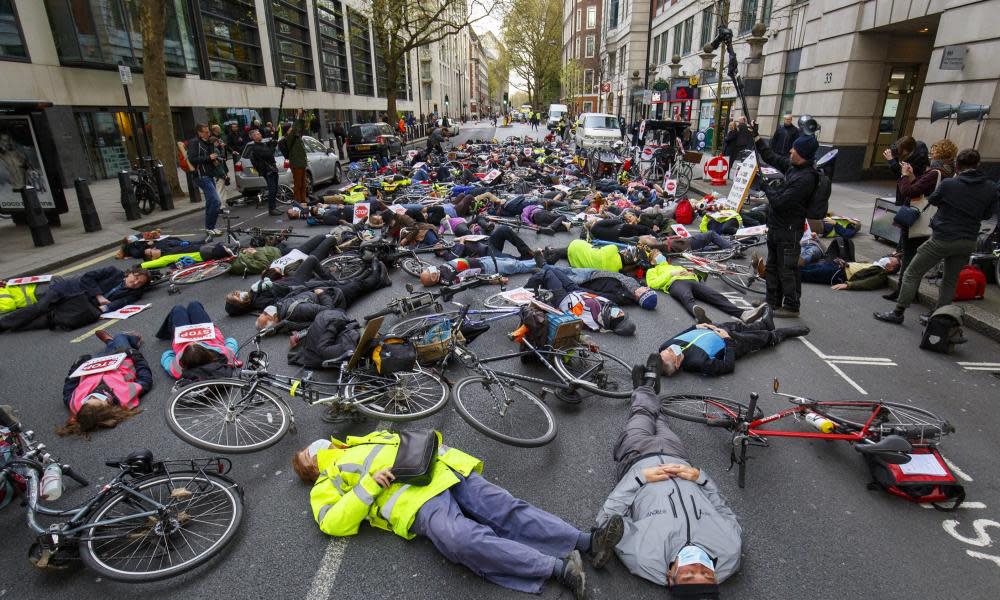Calm UK’s roads to encourage walking and cycling | Letters

Evidence has long been available showing that new roads generate too much extra traffic to solve congestion (New roads fail to ease traffic or lift economies, say researchers, 20 March). It is ignored because of intense pressure not only from the motor and construction industries but from a large section of the public. It was clear before the M25 corridor was hacked through the country and communities around London that the development would greatly increase traffic in the area, but it would have taken a brave politician to stop the destruction and switch to more forward-looking solutions.
This is not to question the value of the CPRE report. Evidence keeps accumulating and the more often and forcefully it is put before politicians and the public the better. But change is likely to be slow, and meanwhile it is also important to press for some damage reduction. The scandal of most road developments is that hardly any of the immense cost is spent to mitigate the impact on people. In Holland many motorways are lined by barriers to reduce noise and by greenery to absorb the fumes. Why are such measures limited and rare here? Apart from motorways, much is spent straightening and widening rural A roads. Why does this work hardly even include provision for pedestrians even where settlements are a short walking distance apart? The cost of adding a strip of paving or grass on one side would be small but of great benefit both to residents and visiting ramblers.
Margaret Dickinson
London
• We need to reduce traffic, not increase it, in order to meet greenhouse gas emissions targets, cut the UK death toll from air pollution of more than 100 people every day, and reduce the misery and mental health problems that traffic noise causes to local residents. People will drive less if the alternatives are more attractive. More cycle paths and footpaths and faster-reacting pelican crossings can encourage people to replace short car journeys with cycling and walking. Bus lanes and priority for buses at junctions can make public transport faster than car driving in urban areas. More frequent and cheaper buses and trains are also vital, and can be funded by an increase in petrol and diesel duty. That last proposal may not be popular, but will reduce congestion and save lives.
Richard Mountford
Tonbridge, Kent
• We need to take steps to tackle loneliness, and walking is a great place to start (Three in four older people feel lonely, survey finds, 21 March). Loneliness suppresses our immune system, knocks years off our life and is associated with poor mental health. Walking helps with feelings of depression and anxiety, with 71% of people experiencing a decrease in levels of depression after going for a walk, and creates opportunities for people to engage with their community.
Designing towns and cities around cars has made our streets less welcoming places to walk and spend time, reducing opportunities for social interaction and adding to feelings of loneliness. Older people are also more likely to be restricted from walking in their local area because of barriers, such as pavement parking, uneven paving, and street clutter.
It’s National Walking Month in May, and also the time when local elections take place and a number of city-regions elect a mayor for the first time. Now’s the time to get future city leaders to commit to creating walking towns and cities across the UK. Walkable neighbourhoods can help strengthen our communities and tackle loneliness. It’s about time we started to build our cities around people, not cars.
Tompion Platt
Head of policy and communications, Living Streets
• Fifty UK cyclists are killed or seriously injured every year, and Peter Walker (Heading for a fall, G2, 22 March) quotes research into how they can be protected, noting that insulating cyclists from fast-moving and unpredictable traffic may help. Two researchers with head-cameras filmed how it was to be a cyclist, with or without a helmet, and dressing as a male or a female, to judge how motorists behaved towards them.
All of this is helpful, but in one of the two most cycled-in cities in the UK, I have a further suggestion: someone must just as carefully film how cyclists behave. Shooting lights and ignoring pedestrian crossings are common, as is cycling without lights in the dark, even showing off by racing, hands off the handlebars. As a mobility-scooter user who on more than one occasion has had to swerve dangerously to avoid being hit by a fast-pedalling cyclist on a crossing, I sense that some cyclists appear to feel entitled to the road, and as a motorist I have a nightmare about hitting one of those cyclists riding in the dark without lights.
The phrase in Walker’s article about cyclists dressed “as if for urban warfare” also deserves examination, as does a comparison between the lean, competition-hungry-looking, crotch-splitting bikes often used in the UK, and the comfy, sit-up-and-beg, luggage-carrying models mostly used in the Netherlands.
As well as scientists studying the behaviour of motorists towards cyclists, don’t fast-moving and unpredictable cyclists need to ask themselves how they too should be responsible for safely sharing our streets with others?
Richard Wilson
Oxford
• Join the debate – email guardian.letters@theguardian.com
• Read more Guardian letters – click here to visit gu.com/letters

 Yahoo News
Yahoo News 
